This time of year, things are a bit slow and predictable in the cellar. The usual week consists of a blending trial here or there in preparation for the spring bottlings. Some topping and checking of SO2 levels is sure to follow. It’s a good time to do barrel evaluations in preparation for the onslaught of barrel salesmen coming in March. And finally, keep tracking malolactic fermentation of the 2010 wines. So, not much too really talk about in a picture page format as far as cellar activities. If you doubt me, well, here is the chromatography.
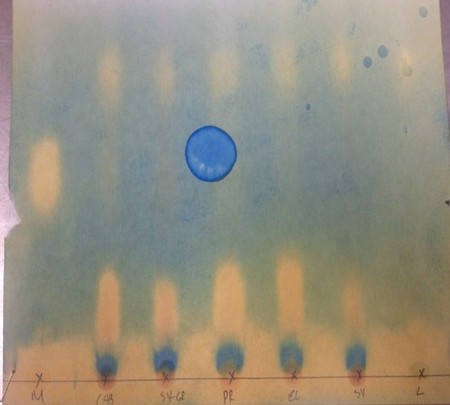
Never mind the big drop of DAP there in the middle, I got a bit too excited. Looks like the Estate Grenache, Block 6 Syrah, and maybe the Glen Rose Syrah are ready to go. Yeah, that’s the stuff of award winning blogging eh?
So instead, I’d like to talk a little about something else happening right now that has a massive impact on wine quality for 2011. We started pruning the vines last week. The way a vine is pruned is the first step you take in influencing the fruit of the next vintage. Pruning basically outlines how much fruit we want each vine to produce, while also limiting the amount of energy used in vegetative growth. Here is what the now dormant vines look like; this is Malbec in case you were wondering.
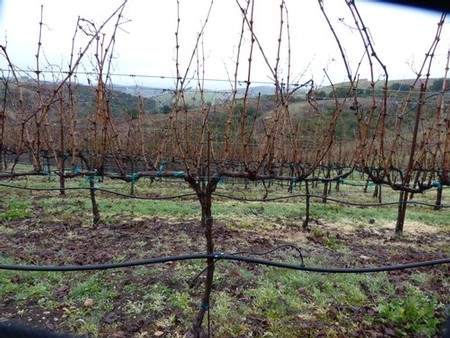
(These vines were planted in 2002! Things grow slowly on limestone.)
Ah, the blank canvas for the pruning shears. It’s time to get to work creating a grape producing masterpiece. Once we are finished, it should look something like this.
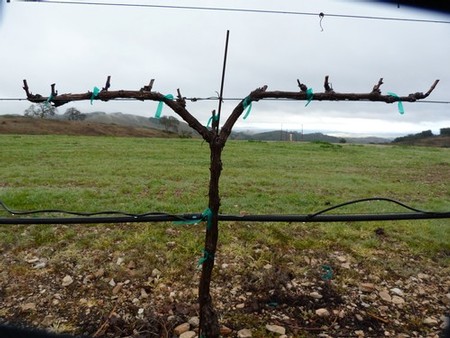
Well, sure, it looks like we hacked away at the thing to leave a vine with a bunch of little stubs. But there is quite a bit of thinking that goes into this. The first time I had to prune I was worthless. I stared, measured, counted my fingers, talked to the vine, everything to make the perfect prune. I was slow to the point of just being in the way. And to top it off, even with all my science and thinking, I was still making bad decisions. After a couple of hours though, the Zen of pruning begins to set in. The points where it is best to clip start to organically appear to you. I’m still no Edward Scissorhands like our vineyard manager Martin, but I can hold my own now.
For the home ranch, we use a cordon training system. The central vertical trunk splits into two permanent horizontal parts. This horizontal part is called the cordon. On the above photo, there are 5 nubs on each side of the cordon. Those nubs are the permanent spur positions, the locations where we will allow the yearly vegetative shoot growth.
Here is a close up shot of a spur position before pruning.
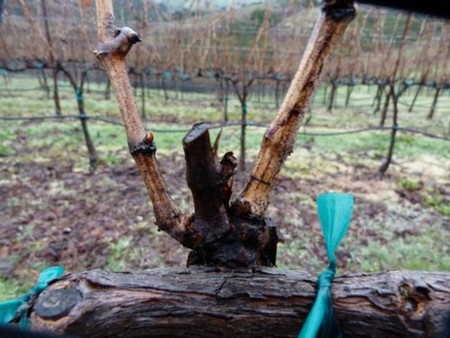
As you can see, two shoots grew from the spur position. This is our first and foremost form of growth control. We want to limit things to 10 Spur positions per vine, thus 20 shoots per vine. And since each shoot will typically only produce two clusters per shoot, we would have 40 clusters per vine in a perfect world. You never get that much fruit, but if left untended until harvest, that would be your max. It makes the fruit dropping that takes place at veraison much easier when pruned like this.
So how do you get the nice perfect two shoots of growth from each spur, well here is a handy photo to demonstrate.
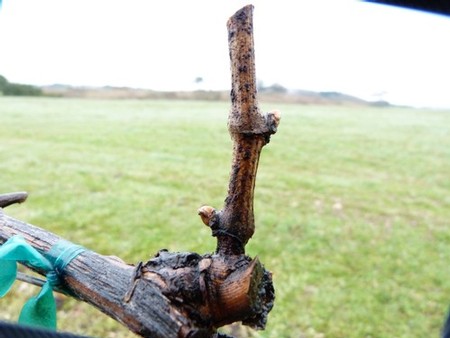
This is not an ideal spur here. The buds, the two white bumps, are too far from the cordon for my liking. But this photo nicely demonstrates the two buds per spur position pruning goal. Ideally, your buds will be really close to the cordon so that each year, the spur becomes a nice tight knot on the cordon. If you see a vine with spurs that are growing way away from the cordon, you got some lazy pruners, possible poor growth, and some angry grape pickers during harvest.
Here is what happens when you let your wine maker learn pruning the previous year.
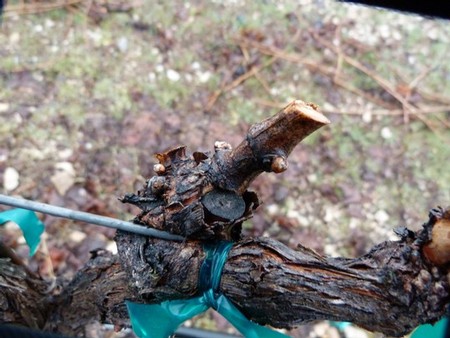
An ugly mess with buds all over the place. Now we will have to come back after bud break and knock off all the excess shoot growth. I let Martin handle this one this year, and he already did a great job of getting it under control. After pruning next year, that spur position will be beautiful.
In my humble opinion it can not be overstated how important vineyard practices like pruning are in determining the final product, the wine. With each cut, we are impacting how the vine will grow, how it will produce fruit, and how healthy it will be. It is a common throw away line in wine maker bios about how “the best wine is made in the vineyard”. This is what is meant by that. Pruning is a back breaking, hand killing endeavor that needs to be carried out as carefully as any sorting, punch down or pressing that happens during harvest. When done correctly with proper care, the foundation for great wine is laid.